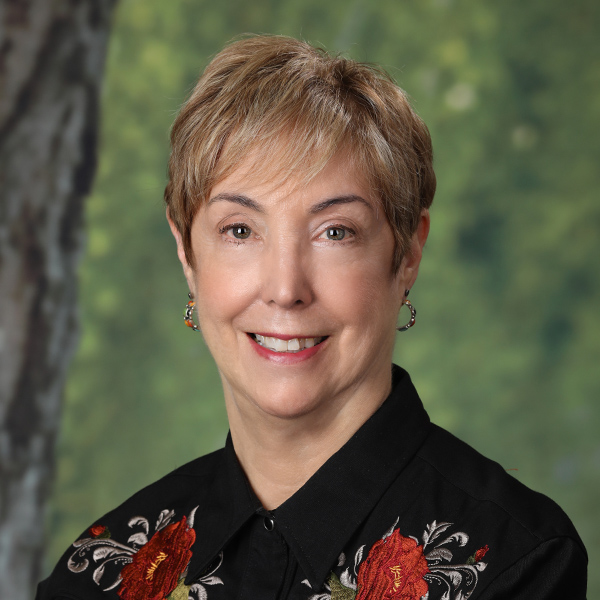Yahoo, It’s Rodeo Time!
Jul 07, 2022 by Tempe Javitz
Yahoo, It’s Rodeo Time!
July is rodeo time in Wyoming and Montana. I grew up
on a ranch just north of Sheridan, Wyoming. The Sheridan
WYO Rodeo was usually the second weekend of July with
four days of parades, wild horse races, saddle and bareback
bronc riding, team roping, barrel racing and calf roping.
Oh, don’t forget steer wrestling!
Nowadays it all begins with the Cody Stampede in Cody,
Wyoming the first week of July, followed by Sheridan’s rodeo
the second weekend, Cheyenne Frontier Days the third week in
July, and Billings, Montana’s Fair and Rodeo in mid-August.
It’s a good thing that branding and moving cattle to the summer
pasture occurs in May or early June. While the cattle are out
grazing in the noonday sun in grass deep to their knees, the
cowboys and cowgirls head to town for some fun.
But, that’s not how it started. First there were little local
rodeos in the ranching communities, such as Kirby, Busby, and
Lodge Grass, Montana. There was no rodeo arena just open prairie.
Some photos reveal a circle of cars or a makeshift fence. Events
were mainly bronc riding (untamed horses) and calf roping. Jessamine
and family were there for the fun. The ladies brought pot luck, and
friends gathered around the Ford touring cars for lunch. Here’s a
photo from July 4, 1928 at Lodge Grass with Burton Brewster (Birney,
MT.) riding Blue Devil. Jessamine’s brother Phil rides to the rescue
on his white horse at the completion of the eight second ride.
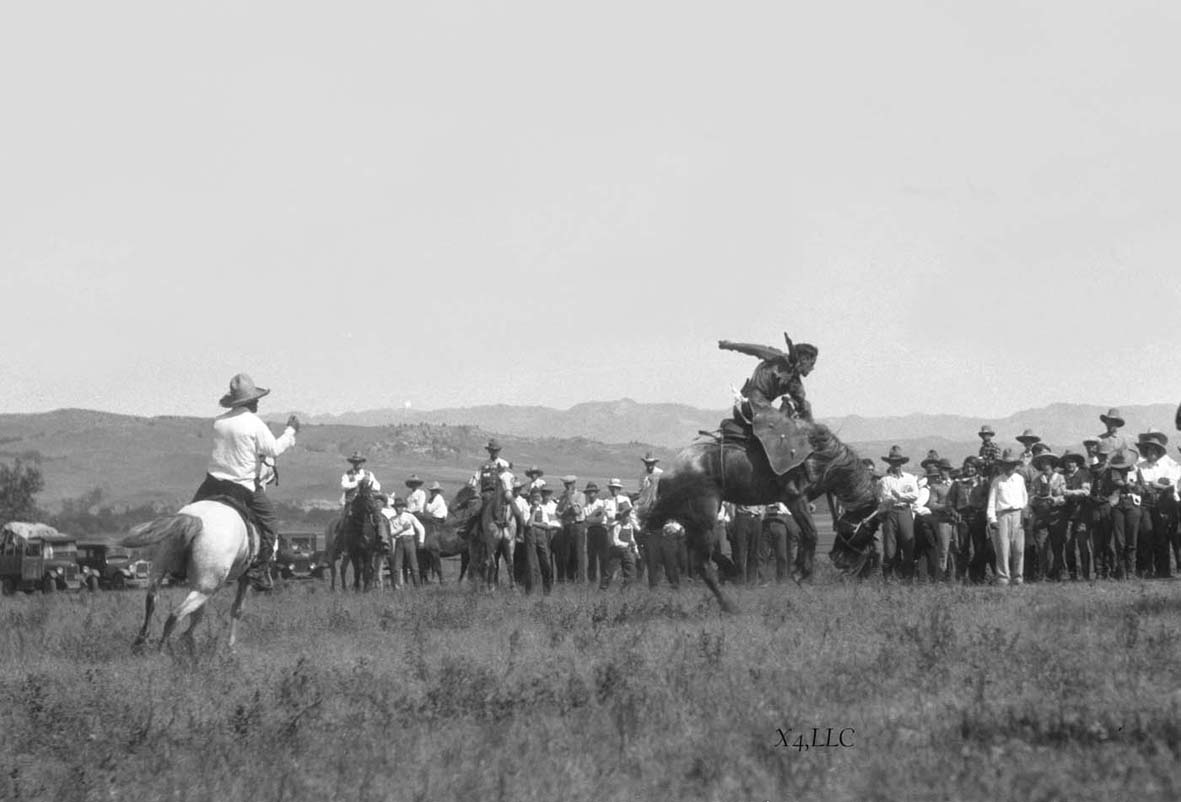
Burton Brewster on Blue Devil
One of the most popular events in the Montana/Wyoming borderlands was
the PK Rodeo staged in 1928 and 1929 on the P.J. Morgan ranch just west
of Sheridan. Mary Morgan, P.J.’s wife, arranged this large event before
the official organization of the Sheridan WYO rodeo. The crowd parked
their cars on the hillside of a natural amphitheater on the ranch and
watched in amazement as the events unfurled on the flat below. In 1928
over 28 states were represented and around 20,000 people attended according
to Kirsten Lynn’s book Let’s Go Rodeo in 2014. In 1929 over 35 state
license plates were counted. Unfortunately, Mary’s health prevented her
from organizing another event in 1930.
My grandmother, Jessamine attended both of Mary Morgan’s PK Rodeos.
A few good photos survive. It’s very difficult to catch fast action with the
early cameras. However, here are two images that will take you back to
July 28, 1928 and the spectacular setting of the PK rodeo.
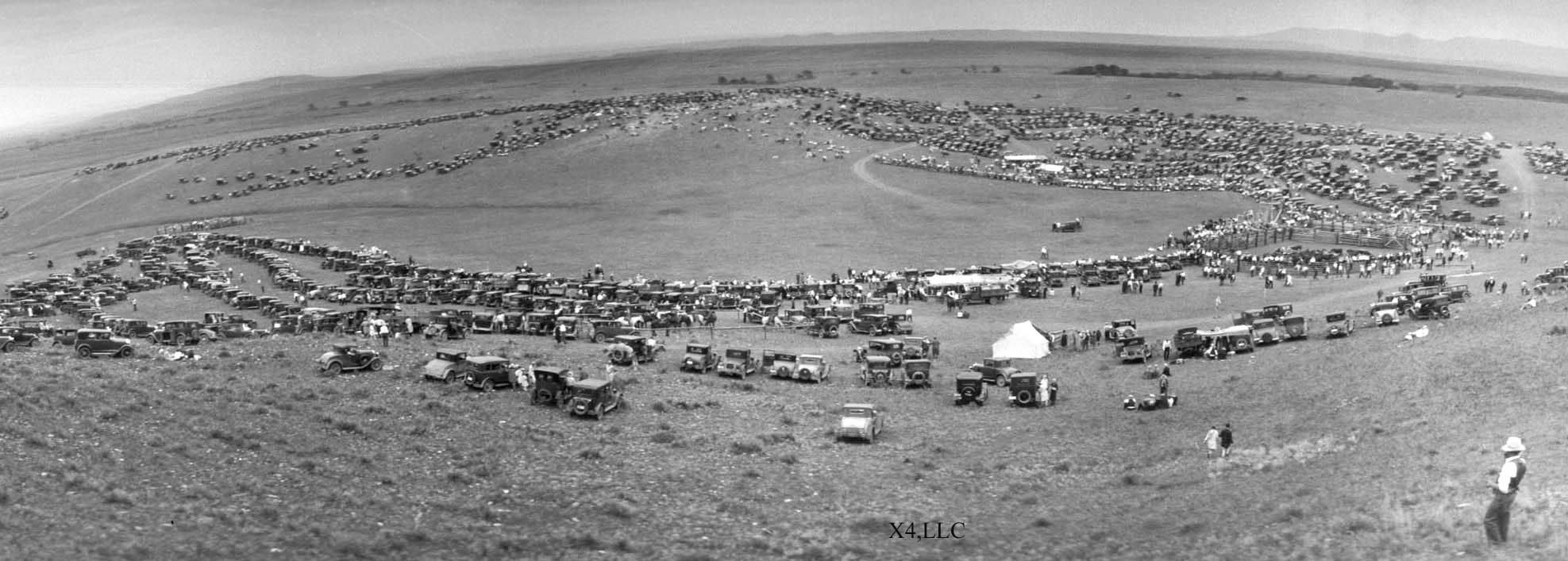
View of the cars creating the arena, July 28, 1928.
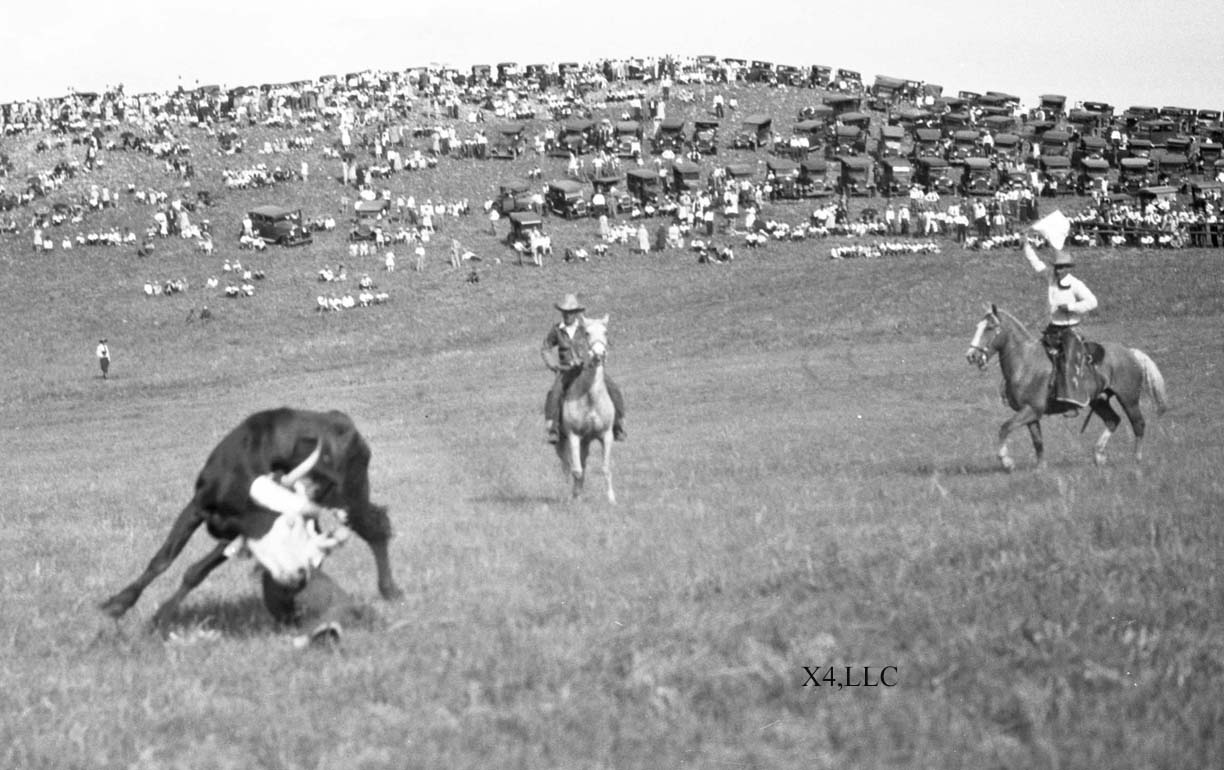
Chuck Wilson competed in steer wrestling, July 1928.
The Sheridan WYO Rodeo started in 1931 and has had only two breaks, WWII and
Covid 19. Many of the contestants from the PK rodeo continued to compete in
the early days of the Sheridan Rodeo. In my family my older brother Robin
competed in high school and college rodeo as a steer wrestler. My sister
Jolly competed in goat tying and barrel racing. My 4-H horse project was
enough for me until I decided to run for the Sheridan Rodeo Queen. I had
to keep up with my sisters, who both had tried out. Jolly was elected rodeo
queen in 1963. In the summer of 1968 when I entered the queen contest, it was
the first time that the contest changed from an applause meter recording to
PRCA rules (Professional Rodeo Cowboy Association). Now you were judged on
personality (an interview), appearance and horsemanship. Queens became
ambassadors for the Sheridan rodeo and attended rodeo events across the state
and encouraged local businesses to support the rodeo.
I had to put together several appropriate outfits, be interviewed by the rodeo
board judges, model my outfit, and most of all compete in the horsemanship
portion. At that time horsemanship garnered the greatest score. This is
what happened. There were six of us completing in the reining pattern. The
pattern included flying lead changes, small and large circles, 360-degree spins,
rollbacks and sliding stops. I was riding my brother’s quarter horse stallion,
Redman. Redman was quiet and gentle, unfazed by all the noise and activity of
the parade and rodeo. However, rollbacks were not his strong point. None of
our patterns were outstanding. In fact, Mickey Badgett’s horse bolted with her
as she started out. (It was her dad’s roping horse and he was looking for calves
to rope!) Our judge, Alida Sage, lined us up and told us to change horses with
the person behind us. Mickey, of course, was right behind me. Convinced all
was lost, I was still determined that her horse would not run away with me!
While changing horses I surreptitiously unbuckled my spurs and threw them under
the fence. That big black rope horse needed no encouragement.
My turn came. Two figure eights, one large, one small and then a gallop towards
the judge with a sliding stop. I barely gave the black his head, with my hair
flying we executed a large circle. Then I turned him into the small circle,
pulling on the off rein until he nearly stood on his hind legs. We flew towards
the judge. Knowing a calf roper’s signal, within the proper distance I put my
right hand on the horse’s shoulder and tugged on the reins. Alida’s grin could
be seen through the clouds of dust as I slid to a stop. I scored the highest
score of the group in horsemanship, and thereby was crowned the queen for the
following year at the Sunday afternoon rodeo. I went on to represent Sheridan
at the State Fair, the Cheyenne Stampede and the Cody rodeo. The queen contest
ended for awhile in 1980, but it is going strong again today.
For more rodeo history I recommend Tom Ringley’s Rodeo Time in Sheridan,
published in 2004 and still available online.
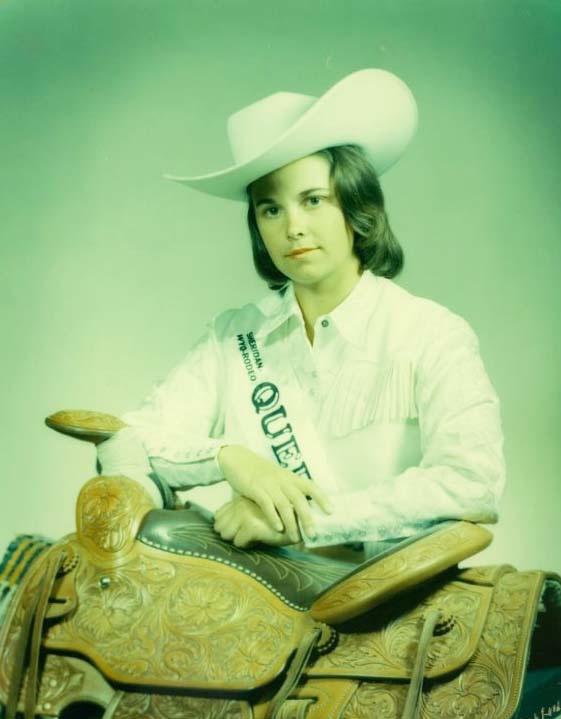
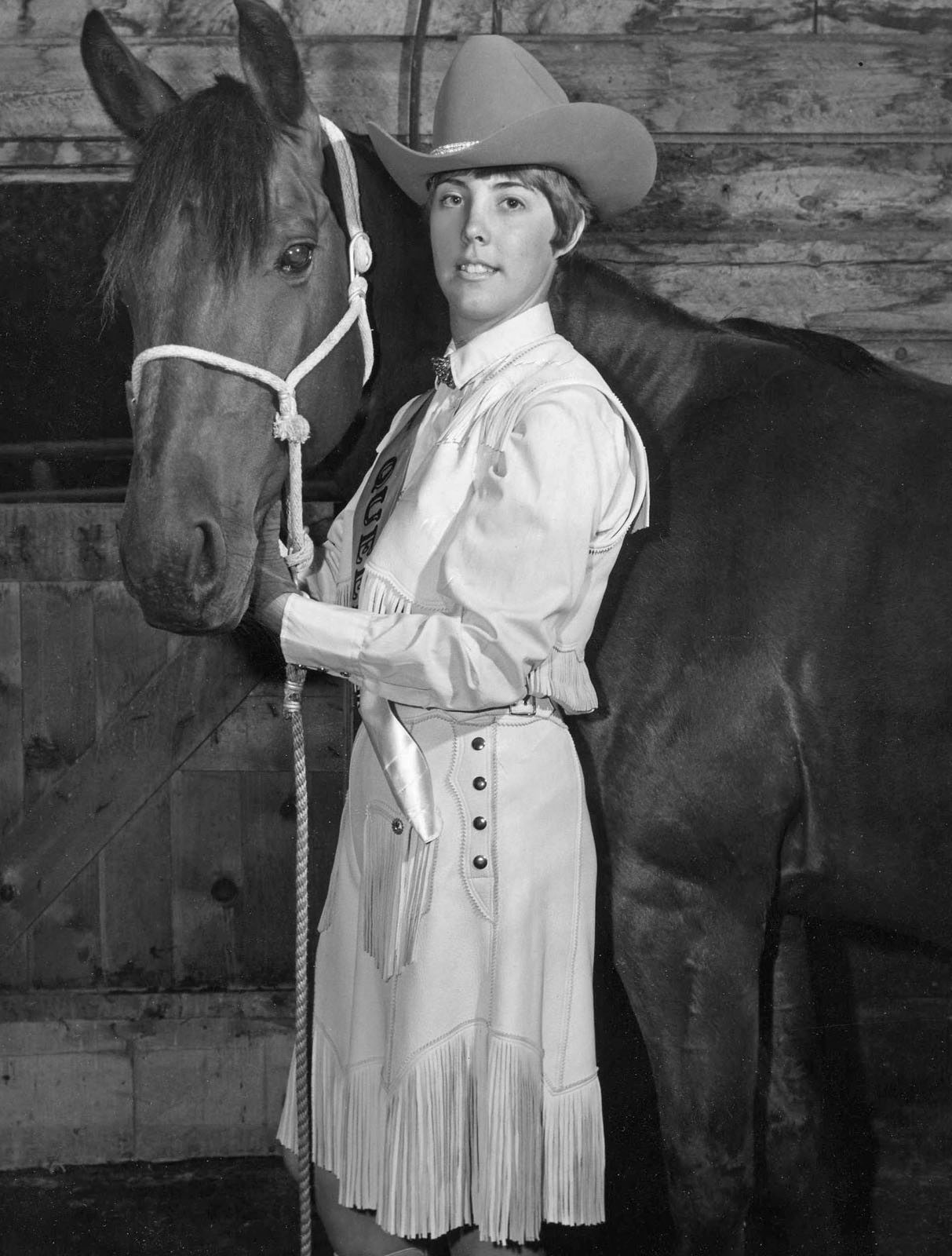
Jolly Johnson (now Tyler) Queen 1963 Tempe Johnson (now Javitz) Queen 1969
And now, my favorite photo, Mr. Print and I in the grand entry at the Wyoming
State Fair in Douglas.
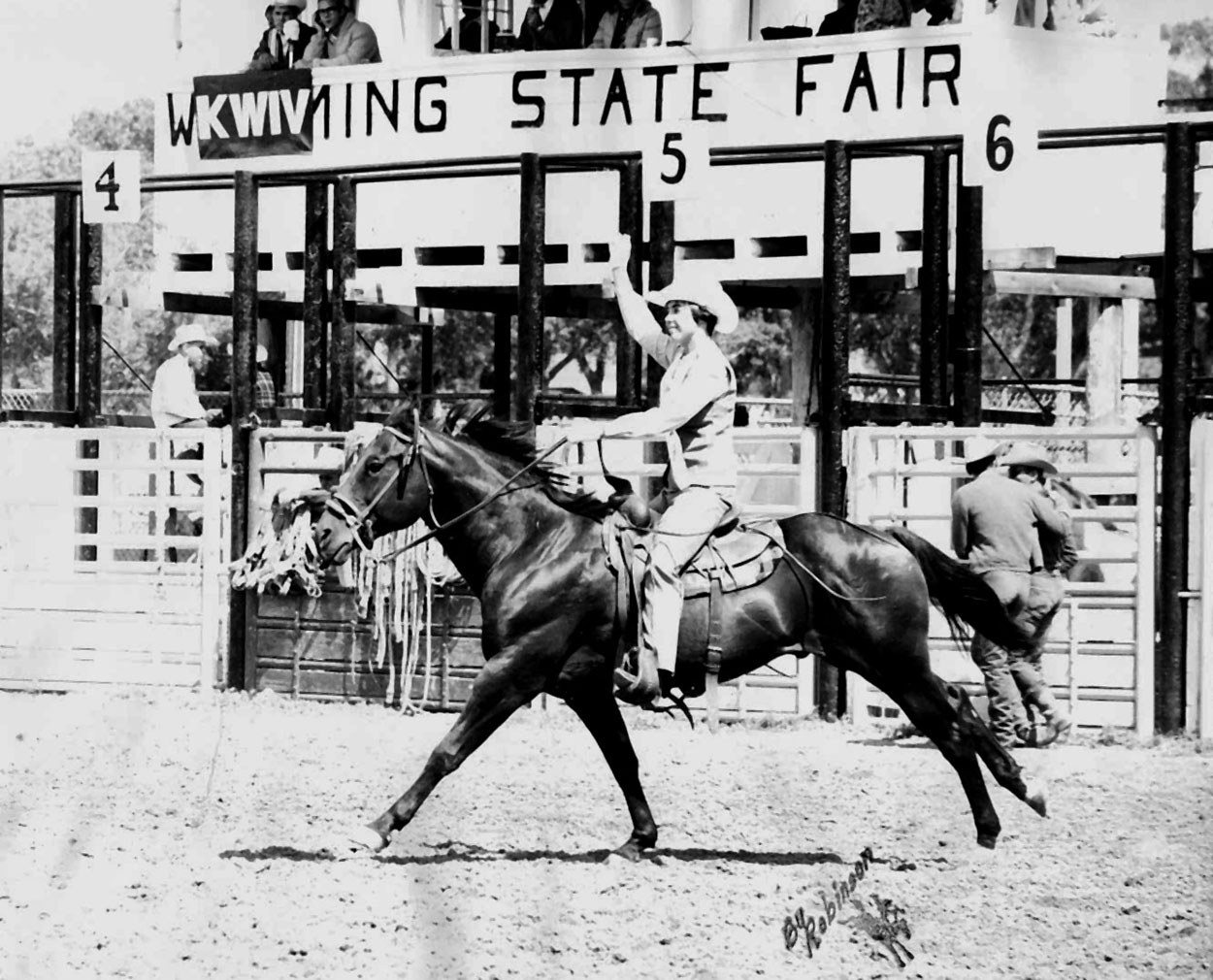
Cowboy Jargon:
Rodeo: A competition among cowboys of roping and riding skills that were
originally developed from working cows. Pronounced roh-DAY-oh or Roh-dee-oh.
The word comes from the Spanish rodear, to surround or encircle.
July is rodeo time in Wyoming and Montana. I grew up
on a ranch just north of Sheridan, Wyoming. The Sheridan
WYO Rodeo was usually the second weekend of July with
four days of parades, wild horse races, saddle and bareback
bronc riding, team roping, barrel racing and calf roping.
Oh, don’t forget steer wrestling!
Nowadays it all begins with the Cody Stampede in Cody,
Wyoming the first week of July, followed by Sheridan’s rodeo
the second weekend, Cheyenne Frontier Days the third week in
July, and Billings, Montana’s Fair and Rodeo in mid-August.
It’s a good thing that branding and moving cattle to the summer
pasture occurs in May or early June. While the cattle are out
grazing in the noonday sun in grass deep to their knees, the
cowboys and cowgirls head to town for some fun.
But, that’s not how it started. First there were little local
rodeos in the ranching communities, such as Kirby, Busby, and
Lodge Grass, Montana. There was no rodeo arena just open prairie.
Some photos reveal a circle of cars or a makeshift fence. Events
were mainly bronc riding (untamed horses) and calf roping. Jessamine
and family were there for the fun. The ladies brought pot luck, and
friends gathered around the Ford touring cars for lunch. Here’s a
photo from July 4, 1928 at Lodge Grass with Burton Brewster (Birney,
MT.) riding Blue Devil. Jessamine’s brother Phil rides to the rescue
on his white horse at the completion of the eight second ride.

Burton Brewster on Blue Devil
One of the most popular events in the Montana/Wyoming borderlands was
the PK Rodeo staged in 1928 and 1929 on the P.J. Morgan ranch just west
of Sheridan. Mary Morgan, P.J.’s wife, arranged this large event before
the official organization of the Sheridan WYO rodeo. The crowd parked
their cars on the hillside of a natural amphitheater on the ranch and
watched in amazement as the events unfurled on the flat below. In 1928
over 28 states were represented and around 20,000 people attended according
to Kirsten Lynn’s book Let’s Go Rodeo in 2014. In 1929 over 35 state
license plates were counted. Unfortunately, Mary’s health prevented her
from organizing another event in 1930.
My grandmother, Jessamine attended both of Mary Morgan’s PK Rodeos.
A few good photos survive. It’s very difficult to catch fast action with the
early cameras. However, here are two images that will take you back to
July 28, 1928 and the spectacular setting of the PK rodeo.

View of the cars creating the arena, July 28, 1928.

Chuck Wilson competed in steer wrestling, July 1928.
The Sheridan WYO Rodeo started in 1931 and has had only two breaks, WWII and
Covid 19. Many of the contestants from the PK rodeo continued to compete in
the early days of the Sheridan Rodeo. In my family my older brother Robin
competed in high school and college rodeo as a steer wrestler. My sister
Jolly competed in goat tying and barrel racing. My 4-H horse project was
enough for me until I decided to run for the Sheridan Rodeo Queen. I had
to keep up with my sisters, who both had tried out. Jolly was elected rodeo
queen in 1963. In the summer of 1968 when I entered the queen contest, it was
the first time that the contest changed from an applause meter recording to
PRCA rules (Professional Rodeo Cowboy Association). Now you were judged on
personality (an interview), appearance and horsemanship. Queens became
ambassadors for the Sheridan rodeo and attended rodeo events across the state
and encouraged local businesses to support the rodeo.
I had to put together several appropriate outfits, be interviewed by the rodeo
board judges, model my outfit, and most of all compete in the horsemanship
portion. At that time horsemanship garnered the greatest score. This is
what happened. There were six of us completing in the reining pattern. The
pattern included flying lead changes, small and large circles, 360-degree spins,
rollbacks and sliding stops. I was riding my brother’s quarter horse stallion,
Redman. Redman was quiet and gentle, unfazed by all the noise and activity of
the parade and rodeo. However, rollbacks were not his strong point. None of
our patterns were outstanding. In fact, Mickey Badgett’s horse bolted with her
as she started out. (It was her dad’s roping horse and he was looking for calves
to rope!) Our judge, Alida Sage, lined us up and told us to change horses with
the person behind us. Mickey, of course, was right behind me. Convinced all
was lost, I was still determined that her horse would not run away with me!
While changing horses I surreptitiously unbuckled my spurs and threw them under
the fence. That big black rope horse needed no encouragement.
My turn came. Two figure eights, one large, one small and then a gallop towards
the judge with a sliding stop. I barely gave the black his head, with my hair
flying we executed a large circle. Then I turned him into the small circle,
pulling on the off rein until he nearly stood on his hind legs. We flew towards
the judge. Knowing a calf roper’s signal, within the proper distance I put my
right hand on the horse’s shoulder and tugged on the reins. Alida’s grin could
be seen through the clouds of dust as I slid to a stop. I scored the highest
score of the group in horsemanship, and thereby was crowned the queen for the
following year at the Sunday afternoon rodeo. I went on to represent Sheridan
at the State Fair, the Cheyenne Stampede and the Cody rodeo. The queen contest
ended for awhile in 1980, but it is going strong again today.
For more rodeo history I recommend Tom Ringley’s Rodeo Time in Sheridan,
published in 2004 and still available online.


Jolly Johnson (now Tyler) Queen 1963 Tempe Johnson (now Javitz) Queen 1969
And now, my favorite photo, Mr. Print and I in the grand entry at the Wyoming
State Fair in Douglas.

Cowboy Jargon:
Rodeo: A competition among cowboys of roping and riding skills that were
originally developed from working cows. Pronounced roh-DAY-oh or Roh-dee-oh.
The word comes from the Spanish rodear, to surround or encircle.
